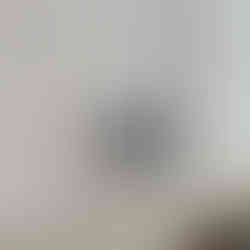Knobs and knockers... :)
- Ruth

- Feb 12, 2016
- 2 min read
My lovely friend Suzanne has just had an amazing kitchen built, in a huge light-filled extension, and the plain iron knobs weren't really doing it justice.
We found an Orla Kiely design (on a scented diffuser, of all places) and borrowed the colour scheme of greys, blues and ivory, which fits really well with her grey-blue kitchen.
I've made enough of each cane to make maybe four knobs each, so there are going to be four or five different designs across the whole kitchen. The colours and the designs are a joy to work with - they make fantastic patterns because there's so much contrast between them.
These are the first stages of the progress - three massive blocks of colour mixed to match the Kiely packaging, a bluey grey, a dark (almost black) grey and a pale ivory.
I needed a bit of a rest after winding that lot through the pasta machine - it must be well over 1kg of clay. I sometimes wish I had splashed out on the £500 motor for my american import Dream Machine (a glorified pasta machine specifically built for polymer clay). But that would have meant the whole machine cost over £800!
The pattern at the bottom left is the first stage in making one of the canes in the next pictures. It's a fairly simple cut-and-recombine pattern courtesy of Meg Newberg (an American polymer clay artist). It's one of my favourites but it can be a pig to get the triangles shaped correctly and to keep the cut sections equal.
Once the clay's been mixed, it's just a case of cutting and reshaping and recombining to create the patterns. That makes it sound easy (and it is!) but it's also very easy to end up with a horrible mush. I think I end up discarding about 30% of canes I make
- you don't throw them away, you just put them back through the pasta machine. Bit galling when you've spent an hour or two creating the pattern in the first place, but it's one of the joys / sorrows of polymer cane work - there's a lot of serendipity involved - you don't really know exactly what you're going to end up with. Which means, of course, that when you make something really spectacular, you're very unlikely to be able to recreate it!
These are a few of the canes / designs that share the same basic colour scheme, with the first knob in the foreground. As you can see, the 'flower' design doesn't come automatically - others are more geometric and less symetrical. Each has its uses but for the handles, I think the central design is the most pleasing, so I will be attempting to make handles that follow the same pattern (even if they're not the same).
The last two pics are of the handles in use. I'm really pleased with them - they add a stylish and totally unique element to a beautiful space.
















Comments